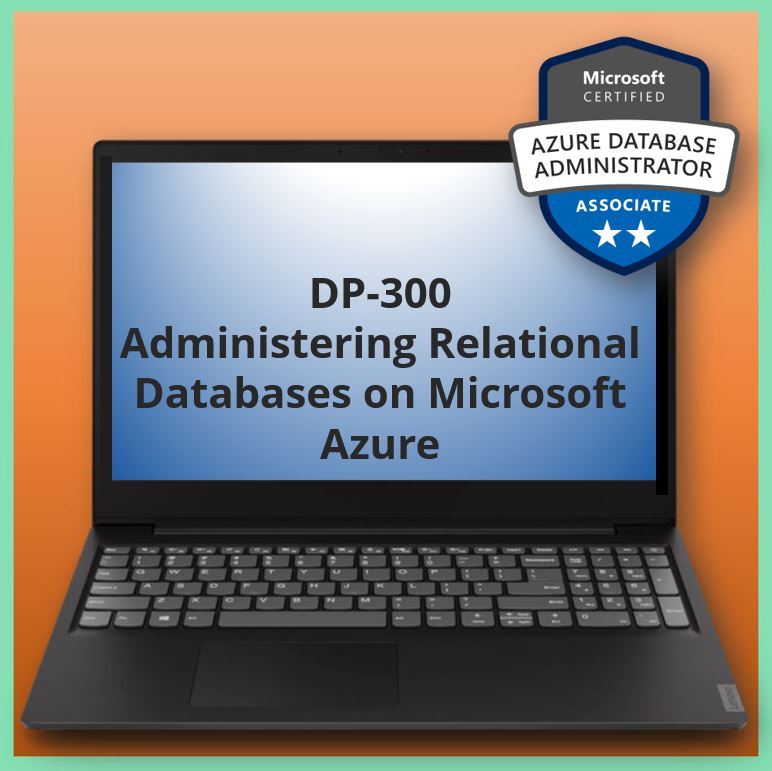Aangeboden leervormen



Administering Relational Databases on Microsoft Azure - DP-300
This course provides students with the knowledge and skills to administer a SQL Server database infrastructure for cloud, on-premises and hybrid relational databases and who work with the Microsoft PaaS relational database offerings. Additionally, it will be of use to individuals who develop applications that deliver content from SQL-based relational databases.

FILMPJE
Voor wie
The audience for this course is data professionals managing data and databases who want to learn about administering the data platform technologies that are available on Microsoft Azure. This course is also valuable for data architects and application developers who need to understand what technologies are available for the data platform with Azure and how to work with those technologies through applications.
Programma
Module 1: The Role of the Azure Database Administrator
This module explores the role of a database administrator in the world of Azure. It also provides some foundational information relevant to the overall content. This includes a review of the various SQL Server-based options (SQL Server in a VM, Managed Instances, and Azure SQL Database.) Students will learn why compatibility level is a crucial concept when working with SQL databases in Azure. Students are also introduced to other database platforms available on Azure in addition to those based on SQL Server, in particular PostgreSQL and MySQL
Lessons
Azure Data Platform Roles
Azure Database Platforms and Options
SQL Server Compatibility Levels
Azure Preview Features
Lab : Using the Azure Portal and SQL Server Management Studio
Provision a SQL Server on an Azure Virtual Machine
Connect to SQL Server and Restore a Backup
After completing this module, students will:
Understand the role of Azure Database Administrator as it fits in with other data platform roles
Be able to describe the key differences between the SQL Server-based database op
Be able to describe the difference between versions and compatibility levels
Know how to enable and disable preview features
Module 2: Plan and Implement Data Platform Resources
This module introduces methods for deploying data platform resources in Azure. You will learn about options for both upgrading and migrating existing SQL databases to Azure. You will learn how to set up Azure resources to host SQL Server on a Virtual Machine, a Managed Instance, Azure SQL Database and either PostgreSQL or MySQL. You will learn how to determine which options are best based on specific requirements including the High Availability and Disaster Recovery (HADR) needs. They will learn to calculate resource requirements and create templates for their deployments.
Lessons
Deploying SQL Server using IaaS
Deploying SQL Server using PaaS
Deploying Open Source Database Solutions on Azure
Lab : Deploying Azure SQL Database
Deploy a VM using an ARM template
Configure resources needed prior to creating a database
Deploy an Azure SQL Database
Register the Azure SQL Database instance in Azure Data Studio and validate connectivity
Deploy PostgreSQL or MySQL using a client tool to validate connectivity
After completing this module, students will:
Deploy resoureces using manual methods
Reconmmend an appropriate databvase offering based on requirements
Configure database resources
Evaluate and implement a strategy for moving a database to Azure
Module 3: Implement a Secure Environment
This module explores the practices of securing your SQL Server Database as well as an Azure SQL database. This includes a review of the various SQL Server-based options as well as the various Azure options for securing Azure SQL Database as well as the databases with reside within Azure SQL Database. . Students will lean why security is crucial when working with databases. . Students are also introduced to other database platforms available on Azure in addition to those based on SQL Server, in particular, Azure Database for MariaDB/MySQL/PostgreSQL
Lessons
Configure Database Authentication
Configure Database Authorization
Implement Security for Data at Rest
Implement Security for Data in Transit
Implement Compliance Controls for Sensitive Data
Lab : Implement a Secure Environment
Configure a server-based firewall rule using the Azure Portal
Authorize Access to Azure SQL Database with Azure Active Directory
Enable Advanced Data Security and Data Classification
Manage access to database objects
After completing this module, students will:
Understand the differences between Windows, SQL Server and Azure Active Directory Authentication
Describe and configure both data-at-rest encryption solutions as well as data-in-transit encryption
Implement a data sensitivity solution
Module 4: Monitor and Optimize Operational Resources
This module will teach you about resource optimization for your databases created using either IaaS or PaaS services. The module also covers monitoring server and hardware resources. It will familiarize you with the various tools available for monitoring performance and establishing a baseline. You will learn how to interpret performance metrics for the most critical resources. You will also learn how to troubleshoot database performance using Azure SQL Database Intelligent Insights.
Lessons
Baselines and Performance Monitoring
Major Causes of Performance Issues
Configuring Resources for Optimal Performance
User Database Configuration
Performance-related Maintenance Tasks
Lab : Monitor and Optimize Resources
Isolate CPU Problems
Use Query Store observe blocking problems
Detect and correct fragmentation issues
After completing this module, students will:
Monitor activity and compare to a baseline
Define maintenance tasks related to performance
Identify major causes of performance problems
Configure resources for optimal performance
Configure a user database for optimal performance
Module 5: Optimize Query Performance
Query execution plans are potentially the most important aspect of database performance. Improving bad plans is certainly an area where a small amount of effort can bring huge improvements. While hardware issues can limit query performance, improving hardware usually yields performance improvements in the 10-20% range, at most. More commonly database administrators encounter queries that are not optimized, have stale or missing statistics, have missing indexes, or poor database design choices that lead to the database engine doing more work than is necessary to return results for a given query. Improving the plans can sometimes yield performance improvements in the 100-200% range or even more, meaning that after improving a plan with better indexes or statistics, a query could run twice or three times as fast! This module provides details on how to analyze individual query performance and determine where improvements can be made.
Lessons
Understanding SQL Server Query Plans
Explore Performance-based Database Design
Evaluate Performance Improvements
Lab : Query Performance Troubleshooting
Identify issues with database design AdventureWorks2017
Isolate problem areas in poorly performing queries in AdventureWorks2017
Use Query Store to detect and handle regression in AdventureWorks2017
Use query hints to impact performance in AdventureWorks2017
After completing this module, students will:
Analyze query plans and identify problem areas
Evaluate potential query improvements
Review table and index design
Determine whether query or design changes have had a positive effect
Module 6: Automation of Tasks
A common goal for database administrators in many environments is to automate as many of their repetitive tasks. This can be as simple as using scripting to automate a backup process, and as complex as building a fully automated alerting system. This module provides details of automating tasks to simplify the DBA’s job. Methods include scheduling tasks for regular maintenance jobs, as well as multi-instance administration and configuration of notifications for task success or failure or non-completion.
Lessons
Setting up Automatic Deployment
Defining Scheduled Tasks
Configuring Extended Events
Managing Azure PaaS resources Using Automated Methods
Lab : Automating Tasks
Deploy an Azure template from a Quickstart template on GitHub
Configure notifications based on performance metrics
Deploy an Azure Automation Runbook (or elastic job) to rebuild indexes on an Azure SQL Database
After completing this module, students will:
Deploy resources using automated deployment scripts
Create scheduled tasks
Create notifications and alerts
Configure automation for PaaS services
Module 7: Plan and Implement a High Availability and Disaster Recovery Environment
Data must be available when the business needs it. That means the solutions hosting the data must be designed with availability and recoverability in mind. Suppose you work for a company that sells widgets both in stores and online. Your main application uses a highly transactional database for orders. What would happen if the server or platform hosting the transactional database had a problem that made it unavailable or inaccessible for some reason? What impact would it have on the business? If the right solution is put in place, the database would come online in a reasonable timeframe with minimal effort, thus allowing business to continue with little-to-no impact. This module and its associated lab cover configuring, testing, and managing a solution for high availability and disaster recovery (HADR) in Azure, for both Infrastructure-as-a-Service (IaaS) and Platform-as-a-Service (PaaS) deployments. This module will not only cover basic requirements, but also the various options available to achieve HADR.
Lessons
High Availability and Disaster Recovery Strategies
IaaS Platform and Database Tools for HADR
PaaS Platform and Database Tools for HADR
Database Backup and Recovery
Lab : Plan and Implement a High Availability and Disaster Recovery Environment
Create an Always On Availability Group
Enable Geo-Replication for Azure SQL Database
Backup to URL and Restore from URL
After completing this module, students will understand:
The difference between recovery time and recovery point objectives
The available HADR options for both IaaS and PaaS
The considerations for planning and configuring HADR solutions including how backup and restore fi
The factors that comprise a HADR strategy
How to configure a high availability solution via a hands-on lab
Voorkennis
In addition to their professional experience, students who take this training should have technical knowledge equivalent to the following courses:
• Azure Fundamentals
• Azure Data Fundamentals
Examen
MICROSOFT DP-300
Direct naar examen: MICROSOFT DP-300
Certificering:
Klik voor meer info over Azure certificering
Duur training
Klassikaal: 4 dagen
Open leercentrum: 4 dagen







